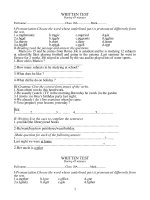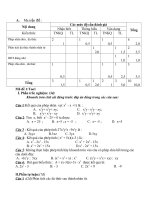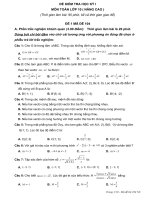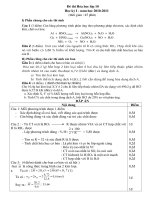bai kiem tra 1 tiet lan 1 lop 12 co dap an
Bạn đang xem bản rút gọn của tài liệu. Xem và tải ngay bản đầy đủ của tài liệu tại đây (478.84 KB, 4 trang )
Co Loa high school
The first test of the first term
English 12
Time allowance : 45 minutes
English Test
(M ®Ò 115)·
C©u 1 :
Jack asked me _____.
A.
where I came from.
B.
where did I come from
C.
where do you come from?
D.
where I am from
C©u 2 :
Americans believe in .......................marriage – a boy and a girl are attracted to each other, fall in
love and decided to marry each other.
A.
contractual
B.
compliment
C.
lucky
D.
romantic
C©u 3 :
Over 1500 new houses _______ each year. Last year, 1720 new houses ____
A.
were built/ were built
B.
are built/ were built
C.
are building/ were built
D.
were built/ were being built
C©u 4 :
“Where did you go last night, Nam?”, said Hoa
A.
Hoa told Nam where he had gone last night.
B.
Hoa asked Nam where he had gone the night before.
C.
Hoa said to Nam where he had gone the night before.
D.
Hoa said to Nam where had he gone the night before.
C©u 5 :
Tom bought that book yesterday.
A.
That book was bought by Tom yesterday
B.
That book was bought yesterday by Tom
C.
That book yesterday was bought by Tom
D.
That book was bought yesterday
C©u 6 :
Peter is said being good at English.
A.
is said
B.
being
C.
good
D.
at
C©u 7 :
Which of the following is used by most people around the world?
A.
Smoke signals
B.
Sign language
C.
Braille
D.
Verbal language
C©u 8 :
He is very brave. His friends are impresses by his bravery.
A.
brave
B.
His friends
C.
are impresses
D.
bravery
C©u 9 :
The war _____ out three years ago.
A.
broke
B.
has broken
C.
was breaking
D.
had broken
C©u 10 :
“What were you doing last night, Mr. John?” The police asked.
A.
The police asked Mr. John what he had done the night before.
B.
The police asked Mr. John what he had been doing the night before.
C.
The police asked what were you doing last night, Mr. John.
D.
The police asked Mr. John what had he been done the night before.
C©u 11 :
I _______this film twice.
A.
have seen
B.
see
C.
will see
D.
saw
C©u 12 :
What ______ to you yesterday?
A.
happened
B.
did happen
C.
has happened
D.
had happened
C©u 13 :
Choose a word in each line that has different stress pattern.
A.
biologist
B.
suppotive
C.
counterpart
D.
contractual
C©u 14 :
11. Hoa: "What a nice dress you are wearing! Lan" Lan: "............................................................"
A.
I think so. I am proud of myself.
B.
Say it again. I like to hear your words.
C.
Not bad
D.
Thanks. That's a nice
C©u 15 :
Some people are concerned with physical .........................when choosing a wife or husband.
A.
attractive
B.
attractively
C.
attraction
D.
attractiveness
C©u 16 :
The farmers _____ in the field now.
A.
are working
B.
have worked
C.
were working
D.
worked
C©u 17 :
She asked me _____ I liked pop music.
1
A.
when B. if
C.
what D. x
C©u 18 :
She said to us “Don’t be late again”.
A.
She said us not to be late again.
B.
She told us to be not late again.
C.
She told us not to be late again.
D.
She told to us not to be late again.
C©u 19 :
This passage mainly tells us that ________.
A.
everybody uses only one form of communication
B.
oral speech is the fastest form of communication
C.
non-linguistic language is invaluable to foreigners
D.
people can make themselves understood in different ways
C©u 20 :
How many different forms of communication are mentioned in the passage?
A.
7 B. 5
C.
11 D. 8
C©u 21 :
Phong ______ at the university so far.
A.
has worked B. had worked
C.
was working D. worked
C©u 22 :
“Can I borrow your pen please, Sam?”, said Gillian.
A.
Gillian asked Sam if she can borrow his pen.
B.
Gillian asked Sam if she could borrow his pen.
C.
Gillian asked Sam she can borrow his pen.
D.
Gillian asked Sam she could borrow his pen.
C©u 23 :
10 . Whistling to get the person's attention is usually considered...................
A.
outgoing B. friendly
C.
welcome D. rude
C©u 24 :
'I'll pay for the meal.'
A.
Sarah insisted of paying for the meal.
B.
Sarah insisted at paying for the meal.
C.
Sarah insisted on paying for the meal.
D.
Sarah insisted to paying for the meal.
C©u 25 :
Choose one word in each group that has the underlined part pronounced differently from the rest.
A.
helped B. asked
C.
shared D. laughed
C©u 26 :
She _____ English before she came to England.
A.
had studied B. studied
C.
studies D. would study
C©u 27 :
“I’m sorry I have to leave so early’, he said.
A.
He apologized to have to leave early.
B.
He apologized for having to leave early.
C.
He apologized to have left early.
D.
He apologized that he has to leave early.
C©u 28 :
Which of the following statements is NOT true?
A.
There are many forms of communication in existence today.
B.
Ideas and thoughts can be expressed by body language.
C.
Blind people can communicate with each other in Braille.
D.
Everyone can use an oral form of communication.
C©u 29 :
'You'd better look for a new job, Andrew.'
A.
Jane advised to look for a new job.
B.
Jane advised looking for a new job, Andrew.
C.
Jane advised Andrew to look for a new job.
D.
Jane advised Andrew look for a new job.
C©u 30 :
Choose a word in each line that has different stress pattern.
A.
confide B. maintain
C.
certain D. oblige
C©u 31 :
By next month, I _____ my first novel.
A.
will have finished B. finish
C.
am going to finish D. will finish
C©u 32 :
It was nice of you to invite me to your birthday party. Thanks very much.
A.
Mike thanked me for to invite him to my birthday party.
B.
Mike thanked me for invite him to my birthday party.
C.
Mike thanked me for inviting him to my birthday party.
D.
Mike thanked me for inviting him to your birthday party.
C©u 33 :
Choose one word in each group that has the underlined part pronounced differently from the rest.
A.
speaks B. photographs
C.
kids D. dates
C©u 34 :
Choose one word in each group that has the underlined part pronounced differently from the rest.
A.
explained B. phoned
C.
decided D. arrived
C©u 35 :
Don't forget to say goodbye to the ........................ before leaving the office.
2
A.
interviewing B. interviewee
C.
interview D. interviewer
C©u 36 :
Choose a word in each line that has different stress pattern.
A.
argument B. sacrifice
C.
apologize D. compliment
C©u 37 :
–Peter, please help me do the washing up. – Sorry, Mum. I ______ TV.
A.
am watching B. had watched
C.
watch D. watched
C©u 38 : 27. The word “verbalization” probably means _________.
A.
body language
B.
picture signs
C.
signal flags
D.
expression in
words
C©u 39 :
The report has not be examined by the committee of experts yet.
A.
has not be
examined
B.
by
C.
committee
D.
yet
C©u 40 :
Mr. John_______ to Los Angeles in 1992.
A.
went B. had gone
C.
has gone D. was going
* Reading the passage carefully and choose thest choice.
Body language expresses ideas or thoughts by certain actions, either intentionally or unintentionally. A wink
can be a way of flirting or indicating that the party is only joking. A nod means agreement while shaking the head
indicates a negative reaction.
Other forms of non-linguistic language can be found in Braille (a system of raised dots read with the
fingertips), signal flags, Morse code, and smoke signals. Road maps and picture signs also guide, warn, and instruct
people.
While verbalization is the most common form of language, other systems and techniques also express human
thoughts and feelings. However, they cannot replace verbal language completely. For instance, no matter how
pictuesque and vivid sign language is, it cannot be used to express spelling.
C©u 19 :
This passage mainly tells us that ________.
A.
everybody uses only one form of communication
B.
oral speech is the fastest form of communication
C.
non-linguistic language is invaluable to foreigners
D.
people can make themselves understood in different ways
C©u 28 :
Which of the following statements is NOT true?
A.
There are many forms of communication in existence today.
B.
Ideas and thoughts can be expressed by body language.
C.
Blind people can communicate with each other in Braille.
D.
Everyone can use an oral form of communication.
C©u 38 : 27. The word “verbalization” probably means _________.
A.
body language B. picture signs
C.
signal flags D.
expression in
words
C©u 20 :
How many different forms of communication are mentioned in the passage?
A.
7
B.
5
C.
11
D.
8
C©u 7 :
Which of the following is used by most people around the world?
A.
Smoke signals
B.
Sign language
C.
Braille
D.
Verbal language
3
phiÕu soi - ®¸p ¸n (Dµnh cho gi¸m kh¶o)
M«n : English
M ®Ò : 115·
01 ) | } ~ 28 { | } )
02 { | } ) 29 { | ) ~
03 { ) } ~ 30 { | ) ~
04 { ) } ~ 31 ) | } ~
05 { ) } ~ 32 { | ) ~
06 { ) } ~ 33 { | ) ~
07 { | } ) 34 { | ) ~
08 { | ) ~ 35 { | } )
09 ) | } ~ 36 { | ) ~
10 { ) } ~ 37 ) | } ~
11 ) | } ~ 38 { | } )
12 ) | } ~ 39 ) | } ~
13 { | ) ~ 40 ) | } ~
14 { | } )
15 { | } )
16 ) | } ~
17 { ) } ~
18 { | ) ~
19 { | } )
20 { | } )
21 ) | } ~
22 { ) } ~
23 { | } )
24 { | ) ~
25 { | ) ~
26 ) | } ~
27 { ) } ~
4









